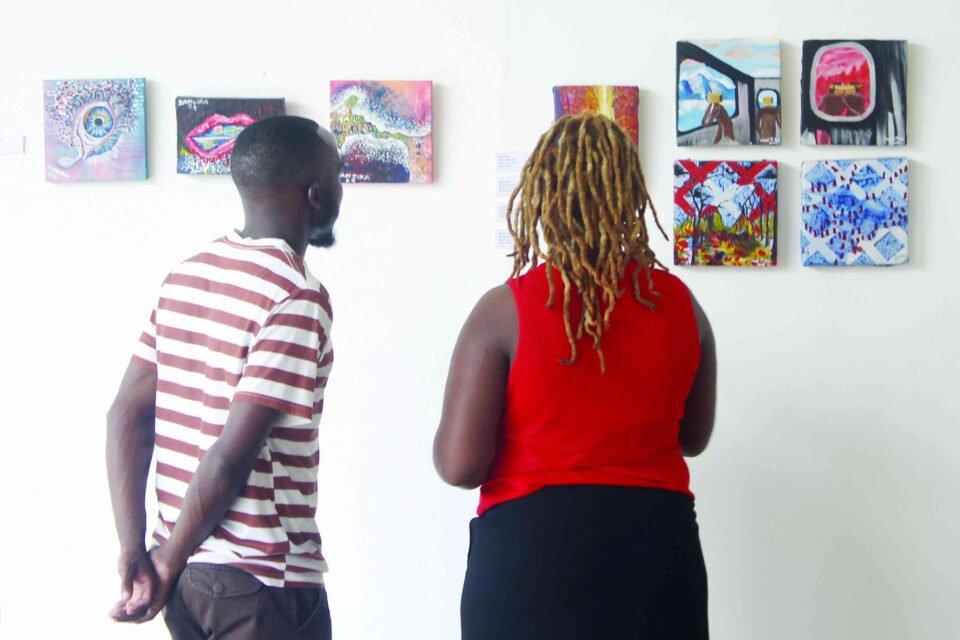
Artworks exhibition titled This is Our World took place at the National Gallery of Zimbabwe (NGZ)
A SMALL-SCALE artworks exhibition titled This is Our World took place at the National Gallery of Zimbabwe (NGZ) in Harare in January this year.
It marked a rare occasion when the audience (whether it knew it or not) was put in a position from which they could look at art from the perspective of the creator.
By drawing the viewer close, miniature-sized works of art induce the eye to automatically adjust and focus on the granular details that reveal an artist’s creative process.
A similar exhibition concept was applied by the late, internationally renowned curator Olabisi (Bisi) Silva through a pop-up project she dubbed The Gallery of Small Things (GoST).
In 2018, presenting the second edition of GoST at the 13th edition of Dak’Art, the Bisi Silva Project (BSP) published the statement “The conceptual and curatorial premise behind this itinerant pop up initiative is to create intimacy in an art world saturated with very large works that need us to move back to experience them.
With GoST, the idea is for the viewer to move forward, move closer to the works to engage them.”
The idea of paying attention to the miniature is a notion expressed in the idiom “Failing to see the forest for the trees,” which warns against missing the bigger picture while obsessing over details.
The bigger picture, however, cannot be the only priority. When things go wrong, another proverb warns, “The devil is in the details.” Inviting a macroscopic point of view of art opens up deeper insights and aligns the viewer’s perspective with the creator’s vision.
Curated by the hardworking duo, Fadzai Muchemwa (curator for contemporary art at NGZ) and Zvikomborero Mandangu (assistant curator), the show includes works by well-known Zimbabwean artists Ishmael Marimirofa, Johnson Zuze, Lin Barrie, Michael Hela, Ann Guild, Hugh Mbaiwa, Lydia Chakuposhiwa, Kelli Barker, Drashti Naik, Johnson Mugabe, Casmia Nyamuba, Louise Hunt, Erhuardt Muchemwa, Joe Chinomona, Charlene Sanzira, Daudi Yves, Tamirirashe Zizhou, Nyasha Matamba, Percy Manyonga and Pritchard Chirume.
Of the exhibiting artists, Marimirofa stands out as the only one who specialises in small-scale artworks and with the most prolific output in three-dimensional works.
Size means different things to the various artists. For Sanzira, whose triptych Giving in drips with feminine eroticism, scaling down her work might be seen as a strategy to avoid crossing a line that invites censorship. Muchemwa (the artist) presents a series of three-dimensional portraits titled Citizen, which are woven from plastic binding strips that are also used for weaving baskets. The delightful portraits look like thumbnails that one wishes to touch and magnify.
The irony with Mugabe’s postage stamps of Nehanda and Kaguvi is that there is no way he could have made his work smaller than its subject matter, just like Zuze’s sculptures of insects. Strict observation will classify Mugabe and Zuze’s works, with Mutamba’s politically charged Our Daily Bread as upscaling.
Mhepo, Manyonga’s series of abstract works made out of sewing thread, is an idea that is begging to be executed in large format.
By exercising self-control and avoiding spectacle, the artist retains focus on the spiritual significance of the work. Chinomona’s several artworks depicting daily lives and quotidian landscapes are like footnotes that highlight important details of life beyond what is taken more seriously. It’s difficult to imagine that Chirume’s family portraits could be more endearing if they were larger, just as Nyamuba and Chakuposhiwa’s works, which are similarly based on intimate relationships. Hunt and Zizhou’s cartographic aerial views suit the medium perfectly. Naik and Guild’s challenging abstract works are like difficult puzzles that demand close attention. Barker and Mbayiwa’s radiantly coloured non-figurative works are as mesmerizing as peering into a distant galaxy through a telescope. Just because the artworks are small does not mean they are easy to understand. Leaning in does not make Hela’s esoteric symbolism any easier to decipher, but the engagement is part of the reward.
An artist’s decision to go small scale and their chosen subject matter might be seen as modesty or understatement, but should never be mistaken for being reductive. Barrie’s triptych Of the land and water is like fragments cut from her larger paintings and maximised for detail. They reveal her exquisite palette and brush work, which could be a total loss if the viewer were standing at a distance and got blown away by her full-size work. In the small work, the viewer feels how the land and water are alive in a deeply mysterious way. Marimirofa’s Njuga dzadya mugwandi is a wire sculpture of a man seated on the ground with his head bowed and a worn blanket over his shoulders.
The title suggests that the subject is a man who has gambled and lost, and it has affected him both materially and emotionally. Because of the proximity required to look at it, the viewer no longer sympathises from a distance, but intimately observes the subject with empathy.
Given explicit permission to move closer to the artwork, viewers discover the difference between looking and seeing. Small works counter the compulsion to judge as people focus more intensely and without noisy mental commentary.
Submerged into a quantum world of nanoscale detail, the audience comes away with deeper and lasting impressions.

